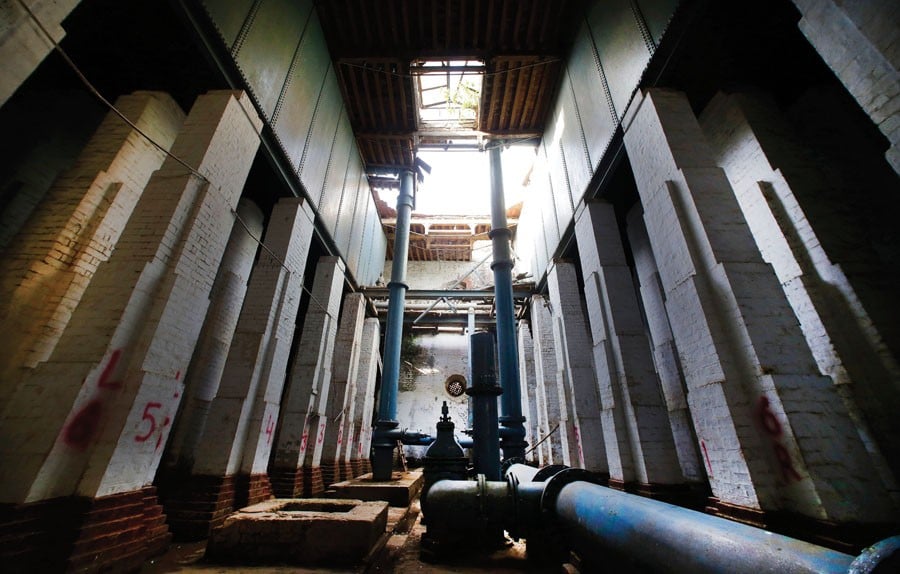
The Walled City continues to benefit from the century-old Paniwala Talaab, either because it is still efficient or because the government is unable to provide a suitable alternative

Built in 1884 under the rule of Sir Charles Umpherston Aitchison, a Scottish-born Lt Governor of Punjab, then a province of British India, and the founder of Aitchison College, the Paniwala Talaab is a glorious reminder of our colonial heritage. Though, it is crumbling, you would still marvel at the mastery with which it was designed to pump water to the entire Walled City of Lahore.
Here’s a massive structure -- composed of four tanks, erected on 512 columns -- that still provides drinking/tap water to the interior Lahore spanning over 2.5 square kilometers and boasting a population of a quarter of a million, almost a century and half later.
"We may curse the Britishers for ruling us, but we cannot escape the fact that they built such great infrastructures and instruments of civil amenities that are still serving us," says Muhammad Ismail, the one clerk who has been working at the Talaab for years now.
The link between water supply and water-borne diseases such as cholera and typhoid was established in the 1850s, and the need for clean, filtered water led to a series of projects. Thomas Hawksley, a British civil engineer known to be the pioneer in public water supply systems in the UK, came up with a solution that combined his expertise in hydrology and goal-gas engineering projects.
The system comprised coal-gas engine used to pump water up into the 12-foot deep tanks with layered filters. Between 1870 and ‘90, Hawkslay set up three clean-water supply systems: Redhill Reservoir and Papplewick Reservoir in Britain, and the third in Lahore, at Langay Mandi, popularly known as the Paniwala Talaab.
The Nottingham England trust was formed in 1974 to conserve the Papplewick Pumping Station site as a static museum. Soon plans to include the refurbishment and regular steaming of engines followed. One of the beam engines was operated in 1975, using the only boiler that was certified to be safe at the time. Since then, the second engine has been reconditioned, and both are steamed several times a year. New visitor facilities were created in 1991, and a major restoration of the structures was completed in 2005.
Following this lead and considering the historic significance of the Paniwala Talaab, the Water and Sanitation Agency (WASA), Lahore, has decided to preserve the steam engine as a heritage for the generations to come and witness the transformation in the history of water service delivery.
For the uninitiated, the said steam engine went out of service post Indo-Pak war of 1965, after the coal supply to the facility was cut. Since then, it had been running on electrical pumps.
"It’s not just a water-supply facility, it marks the advent of technology in the historical timeline of this geographical area," says Zahid Aziz, MD, Wasa. "There is every reason for us to preserve this landmark for the current and future generations to witness.
"We all know that the steam engine is considered the symbol of modern industrial era, and this one is even more significant in the subcontinent because it was among the first used for purposes other than transportation and industrial production."
The engine and the system installed at Paniwala Talaab were manufactured by Hathorn Davery & Co in collaboration with Glenfield Co., which had been used for similar water-works built in the Britain at the time.
When asked if the engine would be renovated to be made available for exhibition and testing, as is being done in England, Aziz says it has been kept in a fairly good shape by Wasa over the years. However, it is not yet decided if that feature would be a part of the initiative.
Celebrated artist and conservationist Ejaz Anwar who shares a special bond with Lahore and is well known for his series of paintings on the city, tells TNS: "Those who make the mistake of forgetting history are forgotten by the history."
He is of the view that preservation of historical landmarks should be every nation’s priority, as it defines them in a way. On a lighter note, he terms the city’s sewerage distribution as another antiquated system that needs to be renovated.
All said and done, there is no denying that a major part of Lahore -- the Walled City -- continues to benefit from the century-old Paniwala Talaab, either because it is still efficient or because the government is unable to provide a suitable alternative.